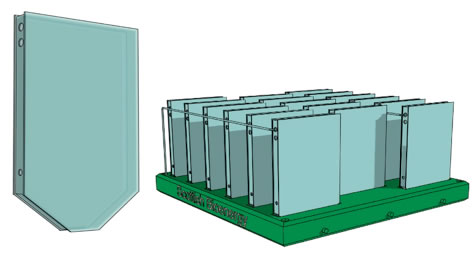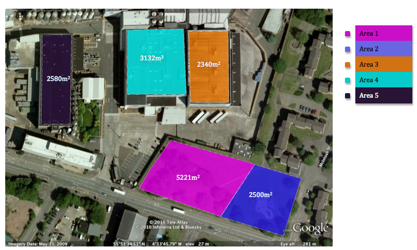There are many possible setups for processing microalgae such as open ponds, tubular photobioreactors and flat panel photobioreactors. These have been tested in a variety of locations, but mostly in hotter tropical regions. The comparison of the different production methods can be seen in Table 1.
|
Open ponds |
Tubular systems |
Flat panel systems |
Risk of contamination |
High |
Low |
Low |
Volumetric Productivity |
Low |
Medium/high |
High |
Energy Input Per Volume |
Low |
High |
Low |
Capital Costs |
Low |
High |
Medium |
Rough Productivity (tonnes/ha.yr) |
20 |
60 |
100 |
Area required |
High |
Medium/low |
Low |
Table 1 : Comparison of systems
From the table it can be seen for the urban area dealt with in this project the best solution is to use the Flat Panel (FP) reactors setup. A big contributor to the cost of microalgae is the harvesting of the biomass and the system used to circulate the biomass. With a FP reactor the collecting of the biomass is done in a harvesting tank and the cheapest option for circulation is an airlift pump, although it is still about 24% of the total production cost.
One of the major problems in production of microalgae is the energy required (energy input) in the production per kilogram of biomass compared to the actual energy content of the biomass produced. It has been found through studies done by the company Subitec that only FP Airlift (FPA) reactors can actually produce biomass with a higher energy output through using biomass than actual energy input into the system. So by selecting the FPA reactor the system not only has the highest productivity but also is the only system that doesn’t waste energy. It has been noted that not a lot of investigation has been done into microalgae in the northern hemisphere climates, but due to successful implementation of the FPA reactor systems in Glen turret Whiskey Distillery, it is expected to work to a suitable level in Dennistoun.
The setup consists of lots of individual pallets (Figure 1 a) that contain microalgae and depending on the system requirements, pallets can be added or removed. The pallets are all interconnected (Figure 1 b) and the algae is harvested daily to ensure that there are not high losses during the night. According to studies done productivity in high longitudes is restricted to 260 days a year due to the varying light levels.

Figure 1 : (a)An individual Panel from the system and what a (b) collection would look like.
The system will be supplied with press water from the Tennants brewery that will provide the required nutrients for the process. The main nutrients required to form the microalgae biomass are Nitrogen, phosphorous and potassium but can also absorb silica and iron. But the system also will remove up to 85% of the NOx emissions from the flue gas as its released into the atmosphere.
The plant size was restricted by the available area and so was sized as 5,472m2 (to fit on the roof of the main part of the Tennants brewery).

Figure 2: Locations for biomass plant and Microalgae
The locations chosen for the microalgae were the top of the Tennants brewery (Area 3 and 4) with the possible expansion to area 5 if more microalgae is needed. This is due to the fact that it is close to where the CO2 is released and therefore saves on extra expenses such as piping. The biomass facility will be located in Area 1 and the CHP plant in Area 2.